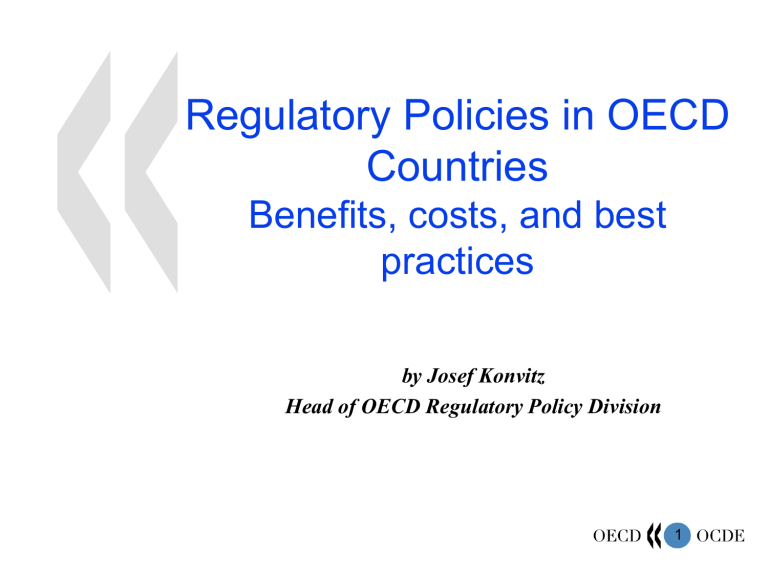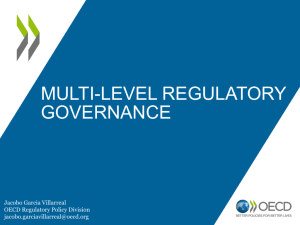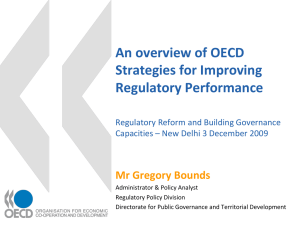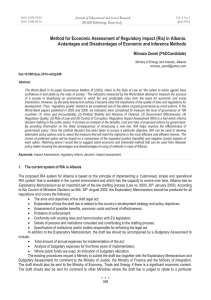Regulatory Reform in OECD Countries
advertisement

Regulatory Policies in OECD Countries Benefits, costs, and best practices by Josef Konvitz Head of OECD Regulatory Policy Division 1 What are regulatory policies? Regulatory policies are designed to maximise the efficiency transparency and accountability of regulations based on an integrated rulemaking approach and the application of regulatory tools and institutions. 2 Regulatory policies improve the functioning of markets Boosts consumer benefits • reducing prices for services and products such as electricity, transport, and health care, and by increasing choice and service quality. Supports sustainable, non-inflationary growth Improves competitiveness • Reducing the cost structure of exporting and upstream sectors in regional and global markets. Fosters flexibility and innovation Increases job creation • by creating new job opportunities, and by doing so reducing fiscal demands on social security, particularly important in ageing populations. Reduces risk of crisis due to external shocks 3 OECD Regulatory Policy Concept Regulatory quality is the driving principle behind reform today Deregulation where markets work better than governments Re-regulation and new regulatory institutions where markets cannot work without governments More efficient government and social regulations to achieve high standards of health, safety and environmental protection at lower economic cost 4 Main Elements of a Regulatory Policy What is a ‘good’ regulation? • • • The 1995 OECD Checklist for Regulatory Quality The 1997 OECD Recommendations on Regulatory Reform The 2005 OECD Principles for Regulatory Quality and Performance Set a Regulatory Policy • Efficiency, transparency & accountability Assure political support • Institution building Set a strategy to drive the Policy • Capacity building for Improving rule-making Reviewing existing regulations Implement the Policy 5 The Regulatory Checklist of the OECD 1995 Recommendations Is the problem correctly defined? Is the government action justified? Is regulation the best form of government action? Is there a legal basis for regulation? What is the appropriate level (or levels) of government for this action? Do the benefits of regulation justify the costs? Is the distribution of effects across society transparent? Is the regulation clear, consistent, comprehensible and accessible to users? Have all interested parties had the opportunity to present their views? How will compliance be achieved? 6 Strategies for Assuring Regulatory Quality I. Building a regulatory management system Regulate the regulators through transparency and accountability mechanisms (laws, policies, institutions, procedures, enforcement, etc.) II. Improving the quality of new regulations Control of the flow (consultation, RIA, alternatives, co-ordination, etc.) III. Upgrading the quality of existing regulations Control of the stock (deregulation, up-dating, codification and restatement, administrative simplification) 7 Since 1997 Twenty multidisciplinary country reviews: Canada, Czech Republic, Denmark, Finland, France, Germany, Greece, Hungary, Ireland, Italy, Japan, Korea, Mexico, Netherlands, Norway, Poland, Spain, Turkey, United Kingdom, United States Detailed assessments of progress in: regulatory management, competition policy, international market openness, sectoral reforms Research on the link between regulatory reform and economic performance 8 Progress Visible developments • Regulatory policy is now on governments’ road map • Rapidly emerging best practices across all fronts • Specific achievements, for example with transparency • Visible development of more competitive markets But • “Whole of government” approach to high quality regulation not • • yet achieved Uneven progress across OECD countries: a growing gap between leaders and the rest Regulatory reform often still perceived to mean a “one-off” effort on specific issues, rather than a continuous, dynamic process. 9 Regulatory reform and economic performance Drivers of economic performance and sustained growth: structural reforms are a powerful complement to fiscal and monetary stabilisation Product market reforms, including regulatory reforms, have a confirmed positive effect • Productivity: countries that have extensively reformed their product markets experienced an acceleration of productivity in the 1990s • Employment: reform can also play an important role in lowering structural employment rates Regulatory policies that help economic performance and market opening • • • Reducing barriers to international trade Promoting domestic competition Simplifying administrative procedures 10 Lessons of experience Leadership as most important ingredient for success Crises as catalyst for change Harmful effects of a short-term perspective Role of central regulatory bodies to change administrative culture Need for communication strategy to build constituency for reform Getting the level of intervention right 11 Towards the future: interface between the public and private sectors Management of complexity of policy objectives, with often unexpected outcomes Greater use of alternatives to regulation Evaluation of regulations and of their social and economic impacts Risk awareness Extending coverage to public services such as education, health, environment 12 Future challenges (1) Cultural change: needs to be promoted across government A culture which is fully aware of the importance of good regulation is not yet fully embedded in administrations Improving the State-citizen relationship is a start, efforts are now needed to improve capacities for effective rule-making Particular weaknesses are the integration of competition principles, and communication between trade policy and regulatory officials Evaluation: integrating the lessons of past experiences Developing a better understanding of the link between regulatory processes and regulatory performance Learning from failures as well as successes Further development and integration of best practices Communication: engaging all stakeholders Engaging currently marginalised but important stakeholders such as SMEs and foreigners Dealing with vested interests Engaging all relevant stakeholders, including the general public 13 Future challenges (2) Putting regulatory policy to work The current agenda still needs attention Deregulation of closed and sheltered product and service markets is still needed in many countries Reforms of the network sectors need to continued, in some cases more vigorously An emerging challenge: the public sector The public sector – “regulation within government” and of public services – has been comparatively neglected The public spending to GDP ratio in the OECD is 40%, so the potential for raising economic performance and social welfare through the application of regulatory quality to this part of the economy is huge Managing competition in public services is an important area for the “regulatory State” Public services at the local government level need special attention 14 Conclusions: Adopt whole-of-government approach; avoid ad-hoc and piecemeal solutions Adopt philosophy of continual improvements; the benefits of reform wear off Learn from each other's experience, including failures as well as successes Change the administrative culture and expectations of citizens 15










